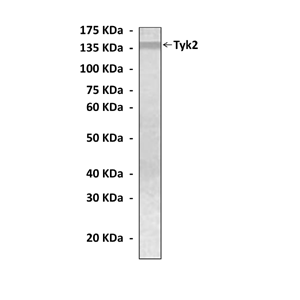Anti-Tyk2: Mouse Tyk2 Antibody |
 |
BACKGROUND Tyk2 belongs to the JAK family of intracellular protein-tyrosine kinases (PTKs), which also includes JAK1, JAK2, and JAK3. These PTKs are unique in having two kinase domains arranged in tandem: a carboxyl-terminal, functional tyrosine kinase (TK) domain and an adjacent kinase-like (KL) domain of unknown function. No other recognizable protein motifs (SH2, SH3, etc.) are present. The JAKs play a crucial role in signaling through cytokine and hormone receptors. It was found that ligand binding to almost all known cytokine receptors induces the tyrosine phosphorylation of one or more JAK family members. One of the best characterized cytokine signaling pathways is the one triggered by IFN-alpha/beta. The involvement in this pathway of two JAKs, Tyk2 and JAK1, was well established. Both kinases have been shown to physically interact with components of the IFN-alpha/beta receptor complex: Tyk2 is associated with IFNAR1, and JAK1 appears to associate with the long form of IFNAR2, called IFNAR2-2 or betaL subunit. Moreover, a functional receptor requires the presence of the two kinases. IFN-alpha/beta treatment induces tyrosine phosphorylation and enzymatic activation of both JAK1 and Tyk2. Phosphorylation at Tyr-1054 and/or Tyr-1055 in the activation loop is required for full activation of Tyk2.1 Once activated, the JAKs initiate the IFN-alpha/beta signaling cascade, whose known steps are the phosphorylation of the receptor chains, the recruitment, activation by tyrosine phosphorylation, homo/hetero-dimerization, and translocation of STAT2 and STAT1 to the nucleus and induce the transcription of target genes. Furthermore, it was also shown that Jaks may also play an essential role in GPCR signaling. Tyk2 signaling is involved in uPA-induced invasion of prostate cancer cells. It was reported that Tyk2 kinase is activated in response to Platelet-activating factor (PAF) in myeloid cells. This activation leads to subsequent tyrosine phosphorylation of STATs 1, 2, 3, and 5. Tyk2 associates with PAF receptor (a GPCR). Moreover, Tyk2 activation by PAF is independent of G-protein coupling.2 In addition, it was reported that Tyk2 was activated by receptor tyrosine kinase FLT3 mutant, ITD-FLT3.3
Tyk2-deficient mice, unlike other Jak kinase mutants, are developmentally normal. It was shown that Tyk2 was not absolutely essential for type I IFN signaling in mice. Thus, the function of Tyk2 in mice appears to be compensated for in vivo, partly by other kinase(s), most likely other Jak(s). However, Tyk2 plays obligatory roles in multiple cytokine signals involved in innate and acquired immunity of humans, which differs substantially from Tyk2 function in mice.4 Furthermore, it was shown that Tyk2 function is critical for the downregulation of metabolic genes upon immune challenge, in particular genes involved in lipid metabolism. Thus, there may be an important regulatory role for Tyk2 in modulating the relationship between immunity and metabolism.5 Additionally, Tyk2 acts in non-haematopoetic systems. It was shown that Abeta-induced activation of STAT3 and caspase-3-dependent neuronal death can be inhibited in tyk2–/– neurons, which suggest the potential involvement of Tyk2/STAT3 signaling in AD pathophysiology.6 Moreover, Tyk2/Jak signaling may also participate in protein synthesis signaling. It was shown that PKR acts as a substrate of activated Jaks, and is phosphorylated at Tyr 101 and Tyr 293. PKR tyrosine phosphorylation provides an important link between IFN signaling and translational control through the regulation of eIF2alpha phosphorylation.7
Tyk2-deficient mice, unlike other Jak kinase mutants, are developmentally normal. It was shown that Tyk2 was not absolutely essential for type I IFN signaling in mice. Thus, the function of Tyk2 in mice appears to be compensated for in vivo, partly by other kinase(s), most likely other Jak(s). However, Tyk2 plays obligatory roles in multiple cytokine signals involved in innate and acquired immunity of humans, which differs substantially from Tyk2 function in mice.4 Furthermore, it was shown that Tyk2 function is critical for the downregulation of metabolic genes upon immune challenge, in particular genes involved in lipid metabolism. Thus, there may be an important regulatory role for Tyk2 in modulating the relationship between immunity and metabolism.5 Additionally, Tyk2 acts in non-haematopoetic systems. It was shown that Abeta-induced activation of STAT3 and caspase-3-dependent neuronal death can be inhibited in tyk2–/– neurons, which suggest the potential involvement of Tyk2/STAT3 signaling in AD pathophysiology.6 Moreover, Tyk2/Jak signaling may also participate in protein synthesis signaling. It was shown that PKR acts as a substrate of activated Jaks, and is phosphorylated at Tyr 101 and Tyr 293. PKR tyrosine phosphorylation provides an important link between IFN signaling and translational control through the regulation of eIF2alpha phosphorylation.7
REFERENCES
1. Gauzzi, M.C. et al: J. Biol. Chem. 271:20494-500,1996
2. Lukashova, V. et al: J. Biol. Chem. 276:24113-21,2001
3. Murata, K. et al: J. Biol. Chem. 278:32892-8, 2003
4. Minegishi, Y et al: Immunity 25:745-55, 2006
5. Claus, V. et al: BMC Genomics 11:199, 2010
6. Wan, J. et al: J. Neurosci. 30:6873-81, 2010
7. Su, Q. et al: EMBO Report 8:265-70, 2007
2. Lukashova, V. et al: J. Biol. Chem. 276:24113-21,2001
3. Murata, K. et al: J. Biol. Chem. 278:32892-8, 2003
4. Minegishi, Y et al: Immunity 25:745-55, 2006
5. Claus, V. et al: BMC Genomics 11:199, 2010
6. Wan, J. et al: J. Neurosci. 30:6873-81, 2010
7. Su, Q. et al: EMBO Report 8:265-70, 2007
Products are for research use only. They are not intended for human, animal, or diagnostic applications.
Параметры
Cat.No.: | CP10242 |
Antigen: | Purified recombinant human Tyk2 fragments expressed in E. coli. |
Isotype: | Mouse IgG1 |
Species & predicted species cross- reactivity ( ): | Human, Mouse, Rat |
Applications & Suggested starting dilutions:* | WB 1:1000 - 1:5000 IP n/d IHC n/d ICC n/d FACS n/d |
Predicted Molecular Weight of protein: | 140 kDa |
Specificity/Sensitivity: | Detects endogenous Tyk2 proteins without cross-reactivity with other family members. |
Storage: | Store at -20°C, 4°C for frequent use. Avoid repeated freeze-thaw cycles. |
*Optimal working dilutions must be determined by end user.
Документы
Информация представлена исключительно в ознакомительных целях и ни при каких условиях не является публичной офертой








